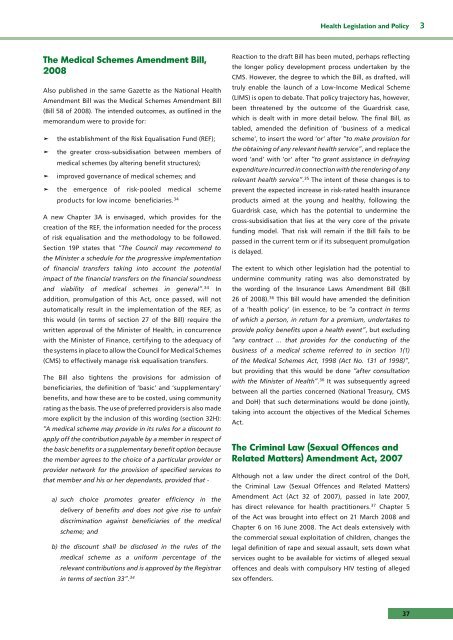South African Health Review 2008 - Health Systems Trust
South African Health Review 2008 - Health Systems Trust
South African Health Review 2008 - Health Systems Trust
You also want an ePaper? Increase the reach of your titles
YUMPU automatically turns print PDFs into web optimized ePapers that Google loves.
<strong>Health</strong> Legislation and Policy 3<br />
The Medical Schemes Amendment Bill,<br />
<strong>2008</strong><br />
Also published in the same Gazette as the National <strong>Health</strong><br />
Amendment Bill was the Medical Schemes Amendment Bill<br />
(Bill 58 of <strong>2008</strong>). The intended outcomes, as outlined in the<br />
memorandum were to provide for:<br />
<br />
<br />
<br />
<br />
the establishment of the Risk Equalisation Fund (REF);<br />
the greater cross-subsidisation between members of<br />
medical schemes (by altering benefit structures);<br />
improved governance of medical schemes; and<br />
the emergence of risk-pooled medical scheme<br />
products for low income beneficiaries. 34<br />
A new Chapter 3A is envisaged, which provides for the<br />
creation of the REF, the information needed for the process<br />
of risk equalisation and the methodology to be followed.<br />
Section 19P states that “The Council may recommend to<br />
the Minister a schedule for the progressive implementation<br />
of financial transfers taking into account the potential<br />
impact of the financial transfers on the financial soundness<br />
and viability of medical schemes in general”. 34 In<br />
addition, promulgation of this Act, once passed, will not<br />
automatically result in the implementation of the REF, as<br />
this would (in terms of section 27 of the Bill) require the<br />
written approval of the Minister of <strong>Health</strong>, in concurrence<br />
with the Minister of Finance, certifying to the adequacy of<br />
the systems in place to allow the Council for Medical Schemes<br />
(CMS) to effectively manage risk equalisation transfers.<br />
The Bill also tightens the provisions for admission of<br />
beneficiaries, the definition of ‘basic’ and ‘supplementary’<br />
benefits, and how these are to be costed, using community<br />
rating as the basis. The use of preferred providers is also made<br />
more explicit by the inclusion of this wording (section 32H):<br />
“A medical scheme may provide in its rules for a discount to<br />
apply off the contribution payable by a member in respect of<br />
the basic benefits or a supplementary benefit option because<br />
the member agrees to the choice of a particular provider or<br />
provider network for the provision of specified services to<br />
that member and his or her dependants, provided that -<br />
a) such choice promotes greater efficiency in the<br />
delivery of benefits and does not give rise to unfair<br />
discrimination against beneficiaries of the medical<br />
scheme; and<br />
b) the discount shall be disclosed in the rules of the<br />
medical scheme as a uniform percentage of the<br />
relevant contributions and is approved by the Registrar<br />
in terms of section 33”. 34<br />
Reaction to the draft Bill has been muted, perhaps reflecting<br />
the longer policy development process undertaken by the<br />
CMS. However, the degree to which the Bill, as drafted, will<br />
truly enable the launch of a Low-Income Medical Scheme<br />
(LIMS) is open to debate. That policy trajectory has, however,<br />
been threatened by the outcome of the Guardrisk case,<br />
which is dealt with in more detail below. The final Bill, as<br />
tabled, amended the definition of ‘business of a medical<br />
scheme’, to insert the word ‘or’ after “to make provision for<br />
the obtaining of any relevant health service”, and replace the<br />
word ‘and’ with ‘or’ after “to grant assistance in defraying<br />
expenditure incurred in connection with the rendering of any<br />
relevant health service”. 35 The intent of these changes is to<br />
prevent the expected increase in risk-rated health insurance<br />
products aimed at the young and healthy, following the<br />
Guardrisk case, which has the potential to undermine the<br />
cross-subsidisation that lies at the very core of the private<br />
funding model. That risk will remain if the Bill fails to be<br />
passed in the current term or if its subsequent promulgation<br />
is delayed.<br />
The extent to which other legislation had the potential to<br />
undermine community rating was also demonstrated by<br />
the wording of the Insurance Laws Amendment Bill (Bill<br />
26 of <strong>2008</strong>). 36 This Bill would have amended the definition<br />
of a ‘health policy’ (in essence, to be “a contract in terms<br />
of which a person, in return for a premium, undertakes to<br />
provide policy benefits upon a health event”, but excluding<br />
“any contract ... that provides for the conducting of the<br />
business of a medical scheme referred to in section 1(1)<br />
of the Medical Schemes Act, 1998 (Act No. 131 of 1998)”,<br />
but providing that this would be done “after consultation<br />
with the Minister of <strong>Health</strong>”. 36 It was subsequently agreed<br />
between all the parties concerned (National Treasury, CMS<br />
and DoH) that such determinations would be done jointly,<br />
taking into account the objectives of the Medical Schemes<br />
Act.<br />
The Criminal Law (Sexual Offences and<br />
Related Matters) Amendment Act, 2007<br />
Although not a law under the direct control of the DoH,<br />
the Criminal Law (Sexual Offences and Related Matters)<br />
Amendment Act (Act 32 of 2007), passed in late 2007,<br />
has direct relevance for health practitioners. 37 Chapter 5<br />
of the Act was brought into effect on 21 March <strong>2008</strong> and<br />
Chapter 6 on 16 June <strong>2008</strong>. The Act deals extensively with<br />
the commercial sexual exploitation of children, changes the<br />
legal definition of rape and sexual assault, sets down what<br />
services ought to be available for victims of alleged sexual<br />
offences and deals with compulsory HIV testing of alleged<br />
sex offenders.<br />
37
















